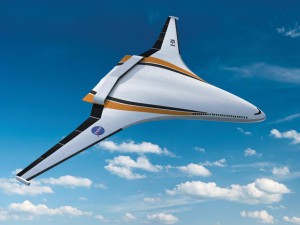March 10, 2015, by Constanza Ahumada
Future commercial airplanes: what to expect
In the last posts, we have discussed the path aircraft industry is following, and in this one, we are presenting some projects that apply the concepts before presented. A couple of months ago, members of the INNOVATE research team had the possibility to attend the IMechE Disruptive Green Propulsion Technologies Conference and more recently the MEA 2015 More Electric Aircraft Conference. Present at both were companies such as Airbus and Rolls Royce, organisations such as NASA and Bauhaus Luftfahrt, and the universities of Cranfield, Cambridge, Georgia, and Nottingham. Each showed different alternatives for the future aircraft.
So, will airplanes have blended wing airframes? Will they have multiple engines (as presented in here )? Will they be electrical? It could be that the answer is yes to all of the alternatives. The solution does not have to be only one of them but a combination, whilst it will also depend on the application of the aircraft. For example, it could be that for a small aircraft a propeller design would be optimal; while for large aircraft, the use of Boundary Layer Ingestion (BLI, which we have already presented in here) could be better. In this way, we will be redefining ways of thinking about aircraft, and not only one solution will be valid. Let us start by having a clearer idea of what the alternatives are and why they are needed.
As presented in the last posts, the next aircraft generation will introduce an almost complete aircraft change, from architecture level to operational one. This change is needed due to the increase in the number of passengers, and the need to reduce the environmental effect of air travel. The increase of passengers generates the need of higher aircraft traffic in order to supply the new demand, this forces more competition in the market to appear and therefore a decrease in the flight fares. In order to comply with these new conditions, the aircraft costs, including fuel and maintenance cost must also be reduced. At the same time, more flights imply more emissions, increasing the environmental impact, which makes also imperative to diminish the fuel consumption per flight.
The change needed will involve different airframes, and a new propulsion system, presenting concepts as BLI (presented in here) and aircraft distributed propulsion (presented in here). In addition, the use of new engines, such as aircraft open rotor engines and hybrid propulsion (that combines electric and fuel propulsion) are also possible solutions. To make the systems smaller, superconductivity may be introduced in the electric system (at transmission and generation level). In this way, the main challenges for the future aircraft technologies are:
- Integration of the aircraft and engine systems.
- Development of ‘multi degree of freedom’ propulsion systems.
- Change of aircraft geometry.
In the aircraft airframe topic, as was presented in link Valerio, one idea is to develop airframes that imitate a bird in order to optimise the aerodynamic properties of the aircraft. To do so the thrust will need to be distributed over the whole wing instead of just one area of it and the materials of it will have to be more flexible. Figure 1 shows one of the possible solutions, that is the use of Blended Wing Body (BWB). Other solutions are the use of High Wing Aircraft, that avoids nacelle diameter constraints; or continue with the classic Wing Airframe.
Figure 1: BWB airframe of N3-X Nasa aircraft from here.
The use of distribution propulsion can reduce up to 85% of noise, 35% of carbon dioxide emissions (CO2), 90% of nitrous oxide emissions (NOx), and 35% of fuel used if new cryogenic fuels are used. At system level, the aircraft architectures may make more use of More Electric Aircraft (MEA) and All Electric Aircraft (AEA), and therefore have a mainly electric architecture. A Hybrid Electric architecture (combines electric and fuel propulsion) is also a solution that helps to reduce CO2 emissions, while keeping the rest of the parameters constant. As the future aircraft may include more than one of these technologies, studies are required to integrate them between each other. Some alternatives presented by Rolls Royce are:
- Non BLI design: use of open rotor engines, or use of high wing aircraft.
- Design incorporating BLI on BWB airframes: they could work with multifan engines or turbo electric distributed propulsion.
- Design incorporating BLI on tube and wing airframes: they can be applied in aircraft with aft fuselage BLI, or with distributed propulsion on tube
- Synergies with hybrid propulsion: use of hybrid electric distributed propulsion.
Independent of the solution, as stated by Bauhaus Lufthart, an innovative idea will have to fulfil the following requirements:
- Add positive value to the industry: A new technology may not give all that we want, but still be a change and be useful to the market.
- Allow evolution: There is possibility of improvement in the future.
- Be scalable: The knowledge has to be able to migrate from one area to another and not depend on only one company.
- Maximise synergy: Improving performance in one system by considering the presence of another.
Also, future aircraft advancement and studies won’t be only in one discipline, such as mechanical, electrical, etc., but will require integration of many. The different fields must work together in order to arrive at the final solution and in this way arrive to an optimal solution, just as we are doing in the INNOVATE project. Finally, in the two links below you can find two videos that represent part of the solutions presented by Airbus for future aircraft generations. One is the EFAN, a fully electric training aircraft based on an all-composited construction that is significantly quieter than a conventional powered aircraft. And the other one is the E-Thrust, the design of a hybrid propulsion aircraft.
Video 1: E-FAN
Video 2: E-Thrust
No comments yet, fill out a comment to be the first


Leave a Reply